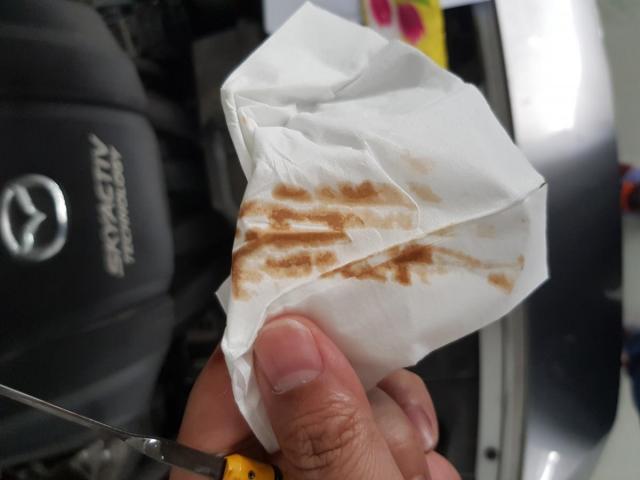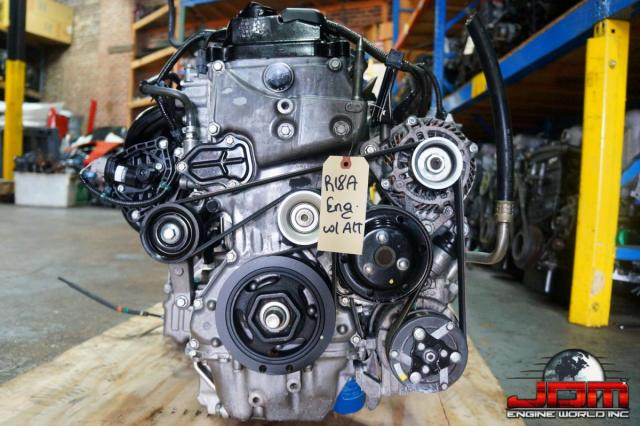Search the Community
Showing results for tags 'engine'.
-
Hi all, anyone experience light clicking or clattering sound in their auto car when during light acceleration? The sound is very much like a manual car accelerating and upshift of gear when the speed for that gear have not been attained.
- 25 replies
-
- 1
-

-
- engine
- clattering
-
(and 5 more)
Tagged with:
-
Hi all, Need your advise on this; I did a servicing recently at a workshop in Ubi area. Decided to check the engine oil about 3-4days later, found that it was dark. Didn't think too much of it until my colleague saw and commented that the color was too dark. Compared his over 10years old car engine oil which was due for servicing, and the colors actually look similar. I contacted the workshop about this, and the boss and worker start telling me that the engine oil color is normal. They specifically say that only a clean/overhaul engine will have clean engine oil... It actually sounds bulls**tty to me, but I need advise on this. You can see the attached image of the engine oil, 4 days after servicing. Is this normal? Should I go and get them to change again? Engine oil is Xado, and I opt for the more expensive oil as it was suppose to be better. Car is Mazda 3 2014, bought in August 2015, last servicing done about 15k before this one. Image of engine oil attached. Note that this is at least after wipe-place in-wipe again checks. Thanks for reading
- 80 replies
-
- 4
-

-
- mazda
- mazdamazda 3
-
(and 4 more)
Tagged with:
-
wat with the rising fuel prices, just wonderin wat are the best gadgets the bros here put in the car just to save fuel thus saving $$$$.pls dun say remove spare tyre hor.....
-
my optra 1.6A is 1.5 years old. I have this problem as mentioned above. any one experiencing the same. Tq
-
What's the best care or best practice? Do we have to switch off our aircon and media player before turning off engine? Any thoughts and considerations? Will it harm the batteries or fuse and etc... please comment
- 140 replies
-
- 2
-

-
- aircon engine audio
- engine
- (and 5 more)
-
Porsche 3D Printing Engine Piston Technology 3D printing technology is already used at Porsche in prototype construction, manufacturing spare parts for classic sports cars as well as in other areas. In cooperation with its partners Mahle and Trumpf, the sports car manufacturer is now establishing a new milestone in the use of additive manufacturing processes for highly-stressed drive components – for the first time, the pistons for the high-performance engine of the 911 flagship model, the GT2 RS, are now also being produced with a 3D printer. 3D printing allows the pistons to be manufactured with a structure that is optimised for the loads acting on the pistons. As a result, the pistons from the advance development project weigh ten percent less than the forged series production pistons. They also have an integrated and closed cooling duct in the piston crown that could not have been produced by conventional methods. “Thanks to the new, lighter pistons, we can increase the engine speed, lower the temperature load on the pistons and optimise combustion,” explains Frank Ickinger from the advance drive development department at Porsche. “This makes it possible to get up to 30 hp more power from the 690 hp twin-turbo engine, while at the same time improving efficiency.”
-
hi all, any idea wats wrong cause i jus filled up engine water into water tank in morning by evening i came back wash car suprised to see almost half of the water gone..there's no leak or nothing but surely something is wrong..any comments? thks alot..
-
Came across an offer for fully synthetic oil (Shell Helix Ultra) and was tempted to buy a few tubs and keep for future use. Synthetic oil are actually a mixture of oil and other chemicals so will it "disintegrate"and becoming unuseable if stored for a period of time (say 2 yrs)? Didn't notice a "use by" date on the container.
-
OK, this is not just about any luxury watch, but a rare one which has unique features not found in any similar product. All watch lover / collector / critic, let me have you thought. Jacob & Co. Launch New Bugatti Chiron Tourbillon, Sporting a 16-Cylinder Engine Jacob & Co. have just debuted a new watch that actually adds some horsepower to your wrist. The new Bugatti Chiron Tourbillon features a 16-cylinder “engine” that actually turns, prompting the 16 pistons to move up and down just like an engine. It even has two turbochargers that rest on either side of the engine block spin when the engine is running. The entire movement of this watch consists of 578 components, making it an incredibly complicated watch. Although, you really didn’t need to know that in order to figure out this is a complex piece of art. It actually took Jacob & Co. just about a full year to develop this watch and its complex movement. Check out the video below form Jacob & Co. where you can learn all about the watch. This is a watch that any Bugatti Chiron owner should add to their collection.
- 42 replies
-
- 23
-

-

-
.png)
-
Pass time with this stop-motion, self-assembling engine video https://www.amazon.com/RuiyiF-Assembly-Hobbies-Operated-Ornaments/dp/B081ZTKD22/ref=sr_1_2?keywords=v2+engine+model&qid=1585730277&sr=8-2
-
- self assembling
- engine
-
(and 1 more)
Tagged with:
-
Giant now selling Mobil 1 5W-30, 10W-30, 0W-40 & 15W-50 for $9.99! Those 946ml bottle. Grab yrs while stock lasts! For those who missed the Shop N Save offer.
-
Everyone says that the 3-cylinder engine is not good. Why do manufacturers still desperately produce it? Recently, I have seen this china YouTuber giving a very good explanation of why manufacturers are giving a bang on a 3-cylinder engine. The disadvantages of a 3-cylinders engine are like a open secret everyone and even the manufacturer knows it. The main reason most of the car manufacturer still goes ahead and produce 3-cylinder engine have 3 core business benefit. And as what the YouTuber is saying, it is like one stone kill three birds. There might be a little dissatisfaction with the consumers but with extensive marketing of the 3-cylinder engine, consumers will still buy. And so the factor that concluded the resurgence of a 3-cylinder engine is fuel economy, emission reduction & R&D costs. Actually 3-cylinder engine is nothing new to the market. Suzuki has been using a straight 3 engine in 1979 on a Suzuki Alto. And some of the notable mention of a 3-cylinder engine car. Subaru Justy Saab 93 Alfa Romeo 33 All these cars have a glorious history about straight 3 engine. But the 3-cylinder was still eventually gotten abandoned by the manufacturer. Mainly is because of the 3-cylinder engine have this unrefined(wobbly) movement that is very annoying. When the 3-cylinder engine is running, although the internal interaction forces are just balanced, but the torque is unbalanced. This would lead to a 3-cylinder engine undulating wavelike motion on both ends. And like a see-saw, the engine will shake from one end to another. In the early days of the 3-cylinder engine not only it will shake, but the sound frequency of the sway when idling at low speed is also close to the frequency of our brainwaves at around 15Hz. This will cause the idling of the 3-cylinder engine to have a very significant noise that is easily detected by humans. There is a lot of complaints in the past, making the manufacturer had to give up on 3-cylinder engine. But nowadays, one of the reasons why the comeback of the 3-cylinder engine is because every country has a stringent environmental protection law and emission guideline. And every government is asking the manufacturer to reduce the car's fuel consumption. There is a US & Japan automotive masterplan that states by 2020, the average car fuel consumption must be less than 6L / 100KM & 4.9L / 100KM. China also has a rule that stipulates the average car fuel consumption must be less than 5L/100KM. So once again, the manufacturer re-introduces the 3-cylinder engine. There are 3 viable ways the car manufacturer can reduce fuel consumption. Firstly, invent and build an electric vehicle, secondly is to reduce vehicle mass weight and lastly is to reduce the amount of fuel burned per revolution. The car manufacturer is clever, so in the end, they still chose the 3-cylinder engine. Because other solutions have obvious disadvantages to car manufacturers. If you want to build an excellent electric vehicle, you need to pour a lot of R&D and investment to specifically research and develop the vehicle structure. Tesla is the world's most famous electric car manufacturer and they only have 4 - 5 models in total for now. But just 2018 itself, Tesla's R&D has spent $1.46 billion. Volkswagen's R&D spending in 2018 was only 14.7 billion. But, Volkswagen group itself have more than 100 models of vehicle on sale. Averagely each model R&D investment is much lower than Tesla. The traditional car companies want to build electric cars on a larger scale, they need to reinvest in R&D costs. Maybe as much as what Mr. Elon Musk has spent and they must be thinking that if I already have the money inside my pockets, why do I still need to fork out? So if building an electric car is not feasible, how about weight reduction? Reducing vehicle weight is also not a good choice. Here's an example, the average fuel consumption of a passenger car in China in 2018 is 5.8L / 100KM, and from the target of 5.0L / 100KM in 2020, there are a 9% fuel savings to be met. Published bt Southwest Aluminum, Aluminum alloy components promote the modernization of the automotive industry. The research report shows usually every 10% of the vehicle's own weight, there will be an 8% reduction in fuel consumption. Simply says, car companies can achieve fuel consumption goals by 2020 by reducing weight 11.2% of weight for each vehicle. The average passenger car in China weights about 1,456kgs. It is equivalent to averagely per car companies need to reduce 163kgs per vehicle. The data released by Gasgoo.com shows every 1kg of a vehicle weight loss, the production cost per car will increase by 60RMB (SGD $12). To sum it up, there will be an increase in 9784RMB (SGD $1,898) of production costs per car. And just a mathematical analogy, Volkswagen sold 10.83 million cars in 2018. If all these cars, the production cost of each car increased by 9784RMB, just imagine how much Volkswagen has to pay per year? It is a whopping 106 billion of manufacturing costs! This is as good as you go down and just want to have a hair cut, but the barber keeps asking you to sign a $200 membership in order to cut for you. The idea is the same, no one wanna fork out the extra for paying the same stuff you are getting. So on the weight reduction part, this is not the optimal solution for traditional car companies. The last resolution will be a 3-cylinder engine left. So how to control the amount of fuel in the 3-cylinders? A research finding from SAIC-GM Pan-Asia Research Center. If the displacement of a single cylinder is small, then the surface ratio will become a larger increased surface cooling loss. With the same small displacement of a 1.5L engine, efficiency of a 4-cylinder engine is significantly lower than a 3-cylinder engine. In laymen terms, 1.5L of 4-cylinder engine is not as fuel-efficient as the 3-cylinder 1.5L. So car companies want to reduce emissions, right? Then the only solutions are 3-cylinder engine. The modern engine mostly are built with modular technology. This helps to reduce the R&D costs for a 3-cylinder engine. BMW has introduced officially of using modular technology, BMW's new B-Series 3, 4, and 6-cylinder engine more than 60% of parts can be shared and parts are shared between gasoline and diesel engines have also reached 40%. Using a unified architecture when developing the engine, and cut off excess cylinder if needed. They just need to do a simple modification with matching components and they can create a 3-cylinder engine! There is no additional research cost at all! So with one less cylinder, it can help the OEM save a whole set of institutions like pistons, rods, spark plugs and so on. These cost savings are immediate. So the end of the day, the 3-cylinder engine not only meets car companies cost reduction, but it also can meet the fuel consumption set by individual governments, and there isn't an additional investment in R&D. With that, I shall present you with the upcoming 3-cylinder engine from the latest 2019 Thailand international motor expo! Nissan Almera Honda City
- 152 replies
-
- 9
-

-
.png)
-
- 3 cyclinder
- engine
-
(and 1 more)
Tagged with:
-
Some car workshops use the vacuum method to suck out the engine oil from the dip stick hole. Is this an effective method of removing sludge from the old engine oil? Or is the convenntional method of allowing the engine oil to drip from the undercarriage a more effective method of removing the majority of the old engine oil?
-
Hi all, Was told by my regular WS after servicing that engine oil started to leak from the engine valve cover & plug seal of my Toyota Axio 1.5L 2007 model. The mechanic showed me the signs which was a streak of oil flowing down and some solid deposits at the valve cover. He quoted about $400 plus including labour for the replacement. Questions: (1) Is the quote reasonable? (2) Any recommended WS if answer to (1) is no? (3) As the lifespan of my Axio is only about a year plus, should I go for re-con parts? Thank you.
-
was just browsing the spec of the new GS 250 (250 only?... where's the 300 and 350?... bloody hell)... and scroll to the bottom "Additional Comments" section... saw "Engine Sound Generator"... WTF iz that?... my gosh.....~~!
- 29 replies
-
https://www.youtube.com/watch?v=OZWeNPi2XkE "47% increase in power, a 45% increase in torque and a 15% reduction in fuel consumption." "...no longer need parts such as the throttle body, camshaft, cam drive, timing gear and cover, wastegate, pre-catalytic converter systems and direct injection systems, helping to further reduce size, weight and complexity." and in China car 1st! http://koenigsegg.com/qoros-debuts-driveable-freevalve-qamfree-engine-at-2016-guangzhou-motor-show/
-

What is the most modern technology used in internal combustion engines?
SGCM_editorial posted a blog entry in MyAutoBlog
The most modern technology used in internal combustion engines currently is Variable compression ratio engine ( VCR ). As the name suggests, the motor may alter the compression ratio under operating circumstances. The technology had existed as a prototype for the previous few years. Currently, Infiniti (the luxury brand of Nissan) is prepared to display its VCR engine, the first ready-to-produce VCR engine, to be exhibited in the 2016 Paris Motor Show. 2016 Paris Motor Show by Maxime Joly, on Flickr Why need a VCR engine? Generally, a traditional petrol engine makes more power from a specified engine size using a turbocharger. In a Diesel engine, Turbocharging's approach looks excellent, as they operate heterogeneously injecting more fuel into denser air. On the other hand, petrol engines do not have the flexibility like diesel engines; a petrol engine's mixing power impacts engine efficiency. Detonation and knocking prevail when the turbocharger boosts over specific concentrations as the general compression ratio rises (piston compress + turbo-added pressure).The first solution to the issue may be to use a reduced engine compression ratio so that more dense air can deliver to the turbo. However, the downside is that lowering the percentage of compression can affect the economy of petrol. Hence the designer must trade-off some Compression ratio for power and rest for the economy. A variable compression ratio engine The main characteristic of the engine is to use a compression ratio of 14 at the lower throttle and low speeds while cruising. So you can achieve the highest fuel economy. The compression ratio of the cylinder falls to about 8:1 during acceleration or high-velocity acceleration, this is also the case when the turbo kicks in. Turbo, therefore, rams more air into the engine, making it more powerful. Infiniti patented such systems at the end of 2001. It is also possible to operate the VC-T (Variable Compression Turbo) motor on Atkinson cycles. Currently, the VC-Turbo engine is paired in INFINITI QX50, a luxury compact SUV that can rival the likes of Lexus NX, Volvo XC40 and Mercedes Benz GLC. "It's currently one of the most affordable premium mid-sized SUV in the market right now" - Julian Kho, Editor of sgCarMart. Join MCF HangOut with Infiniti and Stand a chance to win attractive prizes total worth $1,300! Join MCF HangOut and enjoy attractive savings and discount! Saturday 24th August, 10 am – 1 pm. -
Want to install a light that light up (got maybe 30 sec to one minute only) after switching off engine or when door is open. Any idea where can i tap power from? First came to mind is from cabin door light switch. But the light i want to install is in the engine bay, so its quite a long route to the engine bay. Wondering if any advise where can i tap power from?
-

Hamilton convinced that Ferrari’s engine features a power mode
chitchatboy posted a blog entry in MyAutoBlog
Despite Lewis Hamilton's team winning all seven races so far in the 2019 calendar year, the Formula 1 champion is still weary of his rivals in Ferrari. To be more exact, he feels that Ferrari’s engine features a power mode that his Mercedes does not have. “They were so quick on the straights,” Hamilton remarked in an interview with Autosport. “They definitely have another power mode that we currently don’t have. So, all of a sudden they turn up the power and he (Vettel) pulls away massively on the straight, even if I have DRS open.” Certain that he isn't just talking nonsense, the British driver pointed out that the evidence whereby his team was losing up to six tenths of a second on the straights compared to Ferrari in the Canada's qualifying session. “In the race I know all of a sudden they pick up a lot of pace on the straights [as well] but that’s the name of the game,” “They’ve clearly done a great job with their power unit.” he added. -
Hi car owners with direct injection engine (GDI/Gasoline Direct Injection), would like to understand more about cleaning of carbon deposits on the intake valves. Anyone has experience to share about such cleaning service - chemical or mechanical - is available locally? Or has anyone tried to diy? More info on the need for cleaning can be found here: http://www.aa1car.com/library/intake_valve_deposits_gdi_engines.htm
- 19 replies
-
- gdi
- intake valve cleaning
-
(and 7 more)
Tagged with:
-
I am helping @faidzal a new forum member to post this thread as he is urgently looking for a 2nd hand Honda Stream engine. If I am not wrong, it should be the R18A engine. All the best! @faidzal
-
Dead Christmas Trees To Be Used In The Making Of Engine Oil? “Motor” oil is the lifeblood of any car – unless you drive one of those battery-powered slugs. The lubricating fluid has typically been made from crude oil found underground, or a man-made mixture that creates a synthetic oil. Now, your dead or dying Christmas tree might be the way of the future to create your next oil change. A company called Nexcel has developed a motor oil made entirely from waste, which includes chewing gum and Christmas trees. A myriad of waste items have been recycled in the lab to yield properties required for crucial chemical additives. If Castrol wants our old Christmas trees, will the company be paying a “core charge”? If so, we will need to pay an environmental deposit when we purchase a tree? Castrol innovation business, Nexcel, has produced automotive-grade engine oil using nothing but waste products. Chewing gum, used fryer oil, batteries, bathroom sealant, and even a Christmas tree have been recycled and have yielded vital properties for the ambitious program, which demonstrates the significant potential of re-refined oil. “The project showcases the sustainability potential of waste” says John Ward-Zinski, Nexcel’s sustainability director. “This was a hugely demanding project, completed over the last year. It’s one which we hope will open the public’s eyes as to the importance of recycling and sustainability. Few people would think that discarded Christmas trees and old chewing gum could have a commercial or environmental value, but our engine oil shows this is the case.” According to the press release we received, Nexcel’s ambitious project has been inspired by the company’s innovative sealed-oil cell, which provides vehicle manufacturers with efficiency benefits and promotes used oil collection and re-refinement. “Our system has already been utilized by our technical partner, Aston Martin, for use in the visceral Vantage AMR Pro at last year’s Goodwood Festival of Speed. At that event, the car became the first to tackle the legendary hill climb using re-refined oils,” continues Ward-Zinski. “In 2016, Nexcel and Aston Martin also achieved a podium finish in the competitive VLN Championship at the most arduous racetrack in the world: the Nürburgring. Sustainability, and therefore re-refinement, are of growing global significance; hopefully this project helps demonstrate the extent of what is possible.” Hopefully, the price of an oil change will decrease after Christmas because of a dead tree surplus. The most significant challenges of the project included the yielding of phenols and catechols from the waste to be used as antioxidants, forming the basis of the chemical additives required. Nexcel’s experts worked with a zero-waste goal, and after significant research, analysis of component properties and trial and error, the blend consisted of 180 chewing gum pieces, 500ml of used fryer oil, one gallon of RTV silicone sealant, 14 household batteries, 1-liter of used engine oil, and an old Christmas tree. Extraction of components from these waste items enabled Nexcel scientists to produce 1-liter of automotive engine oil. Finally, a good use for this stuff. “Re-refinement of used oil can create a high-quality product when blended with new additives, but bulk feedstocks made up of many different types of used oils can complicate the process and reduce the yield. Nexcel’s oil-management system avoids this by segregating used engine oil, keeping it in the cell during collection,” says Ward-Zinski. “For this particular project, we wanted to make the oil from waste materials, and the challenge lay in the creation of the chemical additives. However, with creative utilization of modern technology there is huge potential in recycling. It could even help prevent the traditional Christmas tree tip-run needle-drop, from which no car interior has ever recovered.” - https://www.turnology.com/news/motor-oil-trees/
-
- 1
-

-
- castrol
- christmas tree
-
(and 7 more)
Tagged with:
-
Hi all, if you saw my thread about 6 months ago, i drive a '10 Lexus GS450h (s190) car is about 8.5 years old now , but a nightmare happened..... i was stuck in a Jam on the way back from Johor at CIQ. Engine produces diesel like clattering noise. no problem driving yet with no engine light whatsoever. Next, white smoke from exhaust, did not notice any rising temperature levels. After clearing passport, car engine shuts off, the engine still starts , but Temperature level rises to H and does not accelerate. (worst place to have a breakdown, $500 sgd to tow back to sg.....) Workshop diagnosis still not clear, engine taken down from car but yet to open up engine 6 cylinders, only 2 cylinders have normal compression ratio, 1 is completely dead, the remaining 3 are very weak... predicted repair sum they mentioned was upwards of $5k, but no promise that it will not be higher. if Scrapping the car is not an option, how would you repair it? workshop suggested overhaul or new engine ( from scrapyard, if there is any in the first place) any knowledgeable people able to advise on this issue ?? from replacement engine availability , price, any past experiences with similar cars... I did not have predicted a LEXUS to give me 2 big big problems with less than a year on owning...... maybe conti more common but can't find any info regarding present issue on internet... leaving scrapping out, i dont think anyone would wanna spend a fortune on a car with less than 2years coe left.... quotations from workshops that are able to repair at the cheapest possible rates are appreciated too.... your help and advice are deeply appreciated........
-
Hi guys seeking help here for some issues for my ride. Assuming the car has been warmed up after a 45min drive. - approaching traffic light RPM seems to decrease to about 400-500. Engine vibrates but not violently.however it did not stall once. Once coming to a stand still RPM will hover around 600 rpm. Slight vibration felt but car did not stall. All these is when the vehicle is in D mode. - idle in P or N mode have a very slight vibration that seems normal. Around 700-800rpm. Vibration is definitely much lesser than in D mode. - When engaged in R mode. The vehicle will jerk and rpm drops to 600. It reverses normally. No need to step on the gas however vibration can be clearly felt Servicing has been done recently New oil for both engine and transmission New coolant New spark plug New MAF sensor Last but not least. Welcome for any valuable feedback. Thanks!
- 57 replies
-
- 1
-

-
http://www.motorreviewer.com/ Gain a little more knowledge about the engines in your rides. Disclaimer: Not all engines are covered.
-
- 2
-

-
- engine reviews by car make
- reads
-
(and 2 more)
Tagged with:















